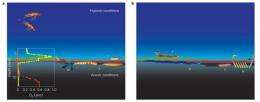May 16, 2011 report
Ancient bacterial mats may have been key to first mobile animals

(PhysOrg.com) -- Researchers from Canada studying the highly salty coastal lagoons at Los Roques, Venezuela and the microbial mats found at the bottom of the sea there, have discovered that oxygen levels in the mats, at least in the day time, are high enough to support the development of mobile life forms. Led by University of Alberta palaeontologist, Murray Gingras, the team writes in Nature Geoscience, that levels of oxygen on the ocean floor were up to four times as high as that near the surface; high enough to support the development of mobile sea life; which the team believes could explain how early life forms could have evolved in waters with high salt concentrations.
The mats, which the researchers believe are likely similar to the type that evolved in some early lagoons during the Ediacaran Period, some 542 million years ago (the time most agree multicellular animals first began to appear) are comprised of a bottom layer of sulphide-oxidizing bacteria, which is covered by a top layer of blue green algae, which produces the oxygen through photosynthesis. They found oxygen levels of between 0.25 and 0.45 atm near the mats, compared to 0.10 at or near the surface.
The findings are important because fossil evidence suggests mobile animals first evolved in early salty lagoons that should have been too salty to produce normal plant growth.
Of course there is one hiccup in the theory, and that is the fact that the mats only produce oxygen during the day when the sun is shining; oxygen levels around the mats plunge at night, leaving the lagoons a very inhospitable place. However, at Los Roques, there are some insect larvae that exist inside the mats that for the most part shut down at night; hibernating, if you will, and thus can survive with almost no oxygen when it’s dark. Gingras and his team support the notion that perhaps some early life forms could have done the same, though others are not quite ready to jump on that bandwagon.
Another issue is that the results are based on the notion that the mats that exist today are in fact the same as the mats that existed way back then; a bit of a leap seeing as how there is really no evidence to support such a supposition. Thus, in order for the ideas suggested in this paper to gain credence, evidence of some similarity will have to be found through further research.
More information: Possible evolution of mobile animals in association with microbial mats, Nature Geoscience (2011) doi:10.1038/ngeo1142
Abstract
Complex animals first evolved during the Ediacaran period, between 635 and 542 million years ago, when the oceans were just becoming fully oxygenated. In situ fossils of the mobile forms of these animals are associated with microbial sedimentary structures1, 2, 3, and the animal’s trace fossils generally were formed parallel to the surface of the seabed, at or below the sediment–water interface4, 5. This evidence suggests the earliest mobile animals inhabited settings with high microbial populations, and may have mined microbially bound sediments for food resources6, 7, 8. Here we report the association of mobile animals—insect larvae, oligochaetes and burrowing shore crabs—with microbial mats in a modern hypersaline lagoon in Venezuela. The lagoon is characterized by low concentrations of dissolved O2 and pervasive biomats dominated by oxygen-producing cyanobacteria, both analogous to conditions during the Ediacaran. We find that, during the day, O2 levels in the biomats are four times higher than in the overlying water column. We therefore conclude that the animals harvest both food and O2 from the biomats. In doing so, the animals produce horizontal burrows similar to those found in Ediacaran-aged rocks. We suggest that early mobile animals may have evolved in similar environments during the Ediacaran, effectively exploiting oases rich in O2 that formed within low oxygen settings.
© 2010 PhysOrg.com


















